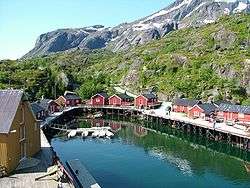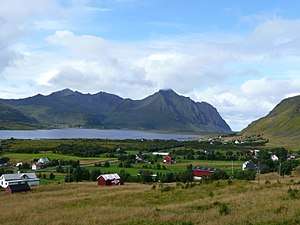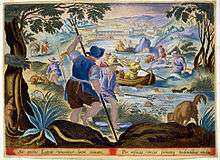Lofoten
Lofoten (Norwegian pronunciation: [ˈlùːfuːtn̩]) is an archipelago and a traditional district in the county of Nordland, Norway. Lofoten is known for a distinctive scenery with dramatic mountains and peaks, open sea and sheltered bays, beaches and untouched lands. Its largest town, Leknes, is approximately 169 km (105 mi) inside the Arctic Circle and approximately 2,420 km (1,500 mi) away from the North Pole, making Lofoten one of the world's northernmost populated regions. Though lying within the Arctic Circle, the archipelago experiences one of the world's largest elevated temperature anomalies relative to its high latitude.
 Reine, Lofoten, seen from top of Reinebringen. | |
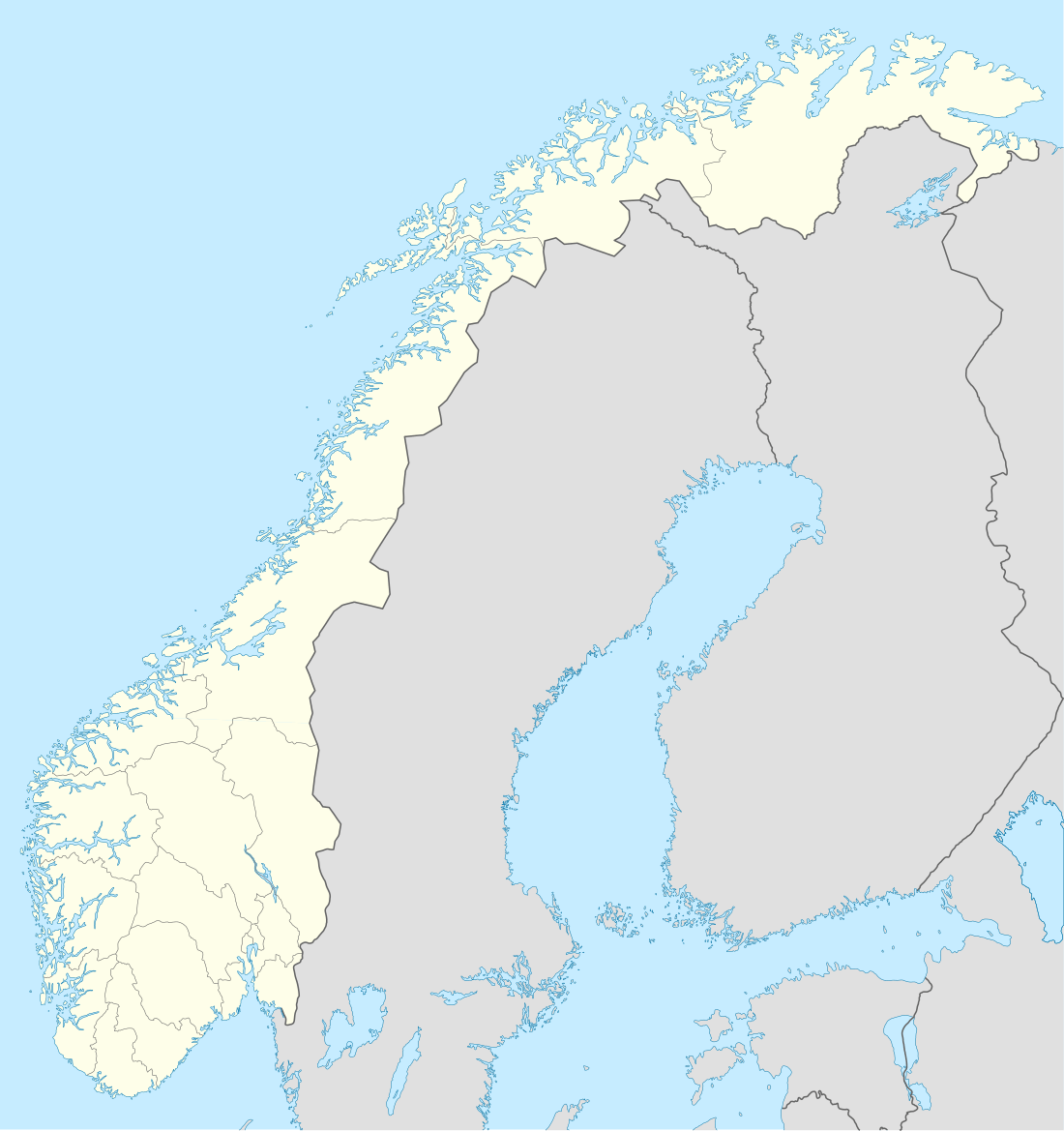 Lofoten location in Norway  Lofoten Lofoten (Nordland) | |
| Geography | |
|---|---|
| Coordinates | 68°20′N 14°40′E |
| Archipelago | Lofoten archipelago |
| Major islands | Austvågøy, Vestvågøy, Flakstadøy, Moskenesøy, Værøy, Røst |
| Area | 1,227 km2 (474 sq mi) |
| Administration | |
Norway | |
| Demographics | |
| Population | 24,500 |
| Additional information | |
| Official website | lofoten |
Etymology
Lofoten (Old Norse: Lófót) was the original name of the island Vestvågøya. The first element is ló (i.e., "lynx") and the last element is derived from Norse fótr (i.e., "foot"), as the shape of the island must have been compared with that of a lynx's foot. (The old name of the neighbouring island Flakstadøya was Vargfót, "wolf's foot", from vargr "wolf".)
History
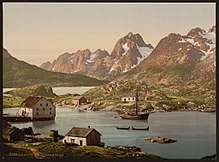
"There is evidence of human settlement extending back at least 11,000 years in Lofoten, and the earliest archaeological sites ... are only about 5,500 years old, at the transition from the early to late Stone Age." Iron Age agriculture, livestock, and significant human habitation can be traced back to c. 250 BC.[1]
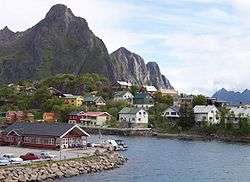
The town of Vågan (Norse Vágar) is the first known town formation in northern Norway. It existed in the early Viking Age, maybe earlier, and was located on the southern coast on eastern Lofoten, near today's village Kabelvåg in Vågan municipality. However, the Lofotr Viking Museum with the reconstructed 83-metre-long longhouse (the largest known) is located near Borg on Vestvågøy, which has many archeological finds from the Iron Age and Viking Age.[2]
The islands have for more than 1,000 years been the centre of great cod fisheries, especially in winter, when the cod migrates south from the Barents Sea and gathers in Lofoten to spawn. Bergen in southwestern Norway was for a long time the hub for further export south to different parts of Europe, particularly so when trade was controlled by the Hanseatic League. In the lowland areas, particularly Vestvågøy, agriculture plays a significant role, as it has done since the Bronze Age.
Lofotr was originally the name of the island of Vestvågøy only. Later it became the name of the chain of islands. The chain of islands with its pointed peaks looks like a lynx foot from the mainland. In Norwegian, it is always a singular. Another name one might come across, is "Lofotveggen" or the Lofoten wall. The archipelago looks like a closed wall when seen from elevated points around Bodø or when arriving from the sea, some 100 kilometres (62 miles) long, and 800–1,000 metres (2,600–3,300 feet) high.
In March 1941 the islands were raided by British Commandos during Operation Claymore, and in a subsequent diversionary attack to support the Vaagso raid in December.
As of 2017, the islands attract one million tourists a year.[3]
Geography
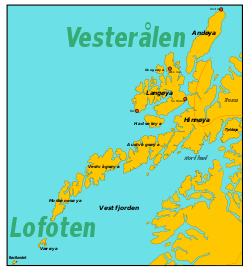
Lofoten is located at the 68th and 69th parallels north of the Arctic Circle in North Norway. It is known for its natural environment within Norway. Lofoten encompasses the municipalities of Vågan, Vestvågøy, Flakstad, Moskenes, Værøy, and Røst. The principal islands, running from north to south are:
- Southern tip of Hinnøya.
- Southern 60% (approx.) of Austvågøy (526.7 square kilometres (203.4 square miles) in total 68°20′N 14°40′E)
- Gimsøya (46.4 square kilometres (17.9 square miles) 68°18′N 14°11′E)
- Vestvågøy (411.1 square kilometres (158.7 square miles) 68°10′N 13°45′E)
- Flakstadøya (109.8 square kilometres (42.4 square miles) 68°5′N 13°20′E)
- Moskenesøya (185.9 square kilometres (71.8 square miles) 67°55′N 13°0′E)
Further to the south are the small and isolated islands of Værøy (67°40′N 12°40′E) and Røst (67°37′N 12°7′E). The total land area amounts to 1,227 square kilometres (474 square miles), and the population totals 24,500. Many will argue that Hinnøya, the northern part of Austvågøy and several hundred smaller islands, skerries and rocks to the east of Austvågøy are also part of the Lofoten complex. Historically, the territorial definition of Lofoten has changed significantly. Between the mainland and the Lofoten archipelago lies the vast, open Vestfjorden, and to the north is Vesterålen. The principal towns in Lofoten are Leknes in Vestvågøy and Svolvær in Vågan. The main islands are joined to each other and the mainland by road bridges. Google Earth view of road bridge from Austvågøy to Vestvågøy
The Lofoten Islands are characterised by their mountains and peaks, sheltered inlets, stretches of seashore and large virgin areas. The highest mountain in Lofoten is Higravstinden (1,161 metres (3,809 feet) in Austvågøy; the Møysalen National Park just northeast of Lofoten has mountains reaching 1,262 metres (4,140 feet). The famous Moskstraumen (Malstrøm) system of tidal eddies is located in western Lofoten, and is indeed the root of the term maelstrom.
Geology
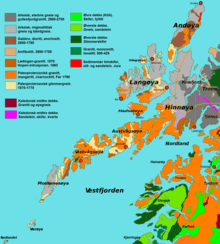
Lofoten is a horst ridge of bedrock.[4] The rocks of Lofoten belong to the wider Western Gneiss Region of Norway.[5] Some of the high relief and irregular surfaces of Lofoten has been attributed to etching that took place during the Mesozoic Era. Evidence of this would be the kaolinite found at some locations.[6] To the northwest the Lofoten archipelago is bounded by the NE–SW-trending West Lofoten Border Fault. This is a normal fault whose fault scarp has been eroded forming a strandflat.[7]
In Vestvågøya mountains have steep slopes towards the open sea in the northwest and southeast while slopes pointing towards the interior of the island are more gentle. This is the result of erosion acting on a landscape that has been uplifted along NE–SW-trending faults in the margins of Lofoten while the interior axis has remained more stable.[4] In tectonic terms mountains are half-grabens and faults are of the dip-slip type.[4]
The sea around Lofoten is known to host significant oil reserves. The reserves amount to 1.3 bn barrels. Oil extraction in the Lofoten area is however prohibited.[3]
Wildlife
The sea is rich with life, and the world's largest deep water coral reef, called the Røst Reef, is located west of Røst.[8] Approximately 70% of all fish caught in the Norwegian and Barents seas use its islands' waters as a breeding ground.[3] Lofoten has a high density of sea eagles and cormorants, and millions of other sea birds, among them the colourful puffin. It has mainland Europe's largest seabird colony.[3] Otters are common, and there are moose on the largest islands. There are some woodlands with downy birch and rowan. There are no native conifer forests in Lofoten, but some small areas with private spruce plantations. Sorbus hybrida (Rowan whitebeam) and Malus sylvestris occur in Lofoten, but not further north.
The animals mistaken for the extinct great auk turned out to be some of the nine king penguins released around Norway's Lofoten Islands in August 1936, there until at least 1944.[9]
Climate
| Skrova/Svolvær (1961–90) | ||||||||||||||||||||||||||||||||||||||||||||||||||||||||||||
|---|---|---|---|---|---|---|---|---|---|---|---|---|---|---|---|---|---|---|---|---|---|---|---|---|---|---|---|---|---|---|---|---|---|---|---|---|---|---|---|---|---|---|---|---|---|---|---|---|---|---|---|---|---|---|---|---|---|---|---|---|
| Climate chart (explanation) | ||||||||||||||||||||||||||||||||||||||||||||||||||||||||||||
| ||||||||||||||||||||||||||||||||||||||||||||||||||||||||||||
| ||||||||||||||||||||||||||||||||||||||||||||||||||||||||||||
Lofoten features a subpolar oceanic climate (Cfc) under the Köppen climate classification. Winter temperatures in Lofoten are very mild considering its location north of the Arctic Circle – Lofoten has the largest positive temperature anomaly in the world relative to latitude. This is a result of the Gulf Stream and its extensions: the North Atlantic Current and the Norwegian Current. Røst and Værøy are the most northerly locations in the world where average temperatures are above freezing all year.[10][11][12]
May and June are the driest months, while October has three times as much precipitation.[13][14] The warmest recording in Svolvær is 30.4 °C (86.7 °F).
Strong winds can occur in late autumn and winter. Snow and sleet are not uncommon in winter, the mountains can have substantial amounts of snow, and in some winters, avalanches might come down from steep mountain slopes. Two of the top ten deadliest rainstorms ever recorded passed through Lofoten.
In Svolvær, the sun is above the horizon continuously ("midnight sun") from 25 May to 17 July, and in winter the sun does not rise from 4 December to 7 January. In Leknes, the sun is above the horizon from 26 May to 17 July, and in winter the sun does not rise from 9 December to 4 January.
The temperature in the sea has been recorded since 1935. At 1 metre (3 feet 3 inches) depth in the sea near Skrova, water temperatures varies from a low of 3 °C (37 °F) in March to 14 °C (57 °F) in August, some years peaking above 17 °C (63 °F). November is around 7–8 °C (45–46 °F). At a depth of 200 metres (660 feet), the temperature is near 8 °C (46 °F) all year.[15]
Sport
Mountaineering and rock climbing
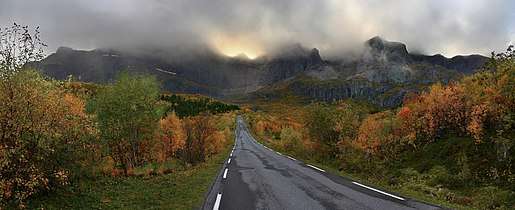
Lofoten offers many rock climbing and mountaineering opportunities. It has 24 hours of daylight in the summer and has Alpine-style ridges, summits and glaciers, but at a height of less than 1,200 metres (3,900 feet). The main centre for rock climbing is Henningsvær on Austvågøya.
The main areas for mountaineering and climbing are on Austvågøy and Moskenesøya. Moskenesøya features remote and serious mountaineering whereas Austvågøy is very popular area for rock climbing. For more information, see the walking guide by Dyer and the rock climbing guidebook by Craggs and Enevold (see references).
Football
Lofoten has one of the world's most unique football pitches. The pitch rests on a rocky islet which has no actual seats.[16] An image of Lofoten featuring the uniquely situated football pitch has been used as the start up screen image for Microsoft Windows.
Surfing
Unstad is one of its better known locations for surfing. Every September surfers from around the world visit to compete in the Lofoten Masters.[17]
Cycling
There is a well marked cycling route that goes from Å in the south and continues past Fiskebøl in the north. The route is part public road, part cycle-path with the option to bypass all of the tunnels by either cycle-path (tunnels through mountains) or boat. Traffic is generally light, although in July there may be a lot of campervans. Some of the more remote sections are on gravel roads. There is a dedicated cycling ferry which sails between Ballstad and Nusfjord, allowing cyclists to avoid the long, steep Nappstraum tunnel. The route hugs the coastline for most of its length where it is generally flat. As it turns inland through the mountain passes there are a couple of 300–400-metre (980–1,310-foot) climbs.
The Lofoten Insomnia Cycling Race[18] takes place every year around midsummer, possible in the midnight sun, but certainly in 24-hour daylight, along the whole Lofoten archipelago.
The Arctic Race of Norway, the world's northernmost professional stage race on road bike which takes place every year in Northern Norway, crossed the Lofoten islands during its first edition in August 2013. The race will be back in 2019 from Thursday 15 August to Sunday 18 August. The first two stages will cross the Lofoten archipelago from west to east.[19]
Transportation
The European road E10 connects the larger islands of Lofoten with bridges and undersea tunnels. The E10 road also connects Lofoten to the mainland of Norway through the Lofast road connection, which was officially opened on 1 December 2007. There are several daily bus services between the islands of Lofoten and between Lofoten and the mainland along E10.
Lofoten is also served by a number of small airports:
- Leknes Airport (101,757 passengers in 2014)
- Svolvær Airport, Helle (74,496 passengers in 2014)
- Røst Airport (9,889 passengers in 2014), which mainly offers flights to Bodø.
- A heliport at Værøy (9,420 passengers in 2014)
- Stokmarknes Airport, Skagen (93,782 passengers in 2016) is located in Vesterålen.
- Harstad/Narvik Airport, Evenes has direct flights to Oslo and Trondheim.
Bodø is often used as a hub for travel to Lofoten. In addition to air travel there is a ferry connecting Bodø to Moskenes. There is also a ferry connecting Svolvær to Skutvik in Hamarøy, with road connection east to E6. Hurtigruten calls at Stamsund and Svolvær.
In popular culture
Literature
- Edgar Allan Poe's short story "A Descent into the Maelström" tells the story of a man who survived his ship being drawn into and swallowed by Moskstraumen.
- Jules Verne's novel Twenty Thousand Leagues Under the Sea (1870) concludes with the Nautilus fallen into the Maelström, and Prof. Aronnax, Conseil and Ned Land, who had been attempting to escape when the Nautilus began its fall, washed up on an island in the Lofotens.
- Johan Bojer's novel The Last of the Vikings (1922) tells the story of the Lofoten cod fishermen.
- In Nikos Kavvadias's poem "The pilot Nagel", pilot Nagel's birthplace was the Lofoten islands.
- In Angela Green's novel The Colour of Water, much of the action takes place in Å i Lofoten and climaxes at the Maelstrom.
- In Ole Edvart Rølvaag's novel Giants in the Earth, the Norwegian protagonists settling in Dakota Territory are immigrants from Lofoten.
- In Thomas Campbell's poem Ode to Winter
Films
- In the film Maelström, Lofoten is where the ashes of Annstein Karson are distributed.
Television
- The Norwegian television crime drama series Twin, which premiered on 27 October 2019 on NRK, is set in the Lofoten Islands.
Paintings
The islands of the Lofoten archipelago are known for their natural environment. The area has rugged landscape and unique lighting. Consequently, the islands have long served as an inspiration for artists. Norwegian painter Gunnar Berg was known for his paintings of his native Lofoten. He principally painted scenes of the everyday life of the local fishermen. Other artists whose work has been associated with Lofoten include Adelsteen Normann, Otto Sinding, Christian Krohg, Theodor Kittelsen, and Lev Lagorio.[20]
Music
In 2004, Nurse with Wound broadcast 24 unexpected radio transmissions from the Lofoten Islands, whose sounds were sourced from the environment and objects found in Lofoten. These recordings are included on their three releases entitled Shipwreck Radio.
Video games
- In the 2015 video game The Witcher 3: Wild Hunt, a village is named Lofoten within the Norse/Celtic inspired archipelago, Skellige.
- In 2019, the World War II video game Battlefield V added Lofoten Islands as a Multiplayer map.
Gallery
Photographs
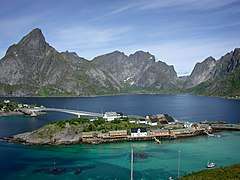 Sakrisøy
Sakrisøy Henningsvær in Lofoten, the harbour during fishing season.
Henningsvær in Lofoten, the harbour during fishing season.- The Lofotr Viking Museum. Borg in Vestvågøy
 Steinsfjorden in Lofoten
Steinsfjorden in Lofoten.jpg) Ramberg beach in Flakstad.
Ramberg beach in Flakstad.
 Stockfish has been exported from Lofoten for at least 1,000 years.
Stockfish has been exported from Lofoten for at least 1,000 years. The view from mount Tjeldbergtinden
The view from mount Tjeldbergtinden Djupfjorden in Lofoten
Djupfjorden in Lofoten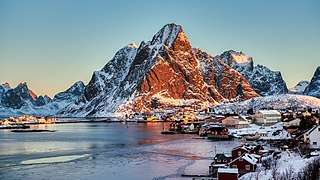 Reine in winter
Reine in winter
Lofoten in art
 fra Lofoten
fra Lofoten
Theodor Kittelsen (1890) Lofoten Island
Lofoten Island
Lev Lagorio (1895) Lofotenlandskap
Lofotenlandskap
Anna Boberg (1910)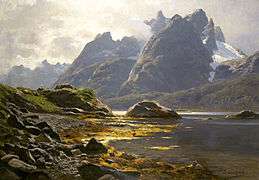 Blick von Lauksund auf Trolltinden am Raftsund, Lofoten
Blick von Lauksund auf Trolltinden am Raftsund, Lofoten
Themistokles von Eckenbrecher (1906)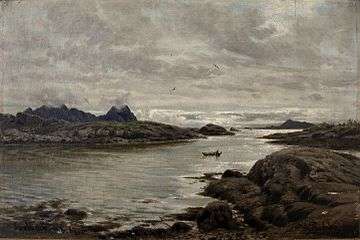 Blick von Svolvaer nach Storemolla und Lillemolla
Blick von Svolvaer nach Storemolla und Lillemolla
Hermann Eschke (1887)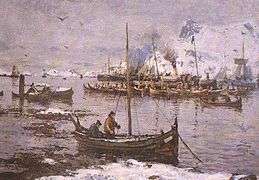 Fra Svolvær i Lofoten
Fra Svolvær i Lofoten
Gunnar Berg
See also
References
- D'Anjou, Robert M.; Bradley, Raymond S.; Balascio, Nicholas L.; Finkelstein, David B. (2012). "Climate impacts on human settlement and agricultural activities in northern Norway revealed through sediment biogeochemistry". PNAS. 109 (50): 20332–20337. Bibcode:2012PNAS..10920332D. doi:10.1073/pnas.1212730109. PMC 3528558. PMID 23185025.
- "Norway – Vestvågøy – Vendalsjord".
- M.F. (29 Aug 2017). "Why Norway may leave $65bn worth of oil in the ground". The Economist.
- Bergh, Steffen G.; Liland, Kristian H.; Corner, Geoffred D.; Henningsen, Tormod; Lundekvam, Petter A. (2018). "Fault-controlled asymmetric landscapes and low-relief surfaces on Vestvågøya, Lofoten, North Norway: inherited Mesozoic rift-margin structures?" (PDF). Norwegian Journal of Geology. 98 (4). Retrieved January 29, 2019.
- Steltenpohl, Mark G.; Hames, Willis E.; Andresen, Arild (2004). "The Silurian to Permian history of a metamorphic core complex in Lofoten, northern Scandinavian Caledonides". Tectonics. 23 (1). doi:10.1029/2003TC001522.
- Lidmar-Bergström, K.; Näslund, J.O. (2002). "Landforms and uplift in Scandinavia". In Doré, A.G.; Cartwright, J.A.; Stoker, M.S.; Turner, J.P.; White, N. (eds.). Exhumation of the North Atlantic Margin: Timing, Mechanisms and Implications for Petroleum Exploration. Geological Society, London, Special Publications. The Geological Society of London. pp. 103–116.
- Osmundsen, P.T.; Redfield, T.F.; Hendriks, B.H.W.; Bergh, S.; Hansen, J.-A.; Henderson, I.H.C.; Dehls, J.; Lauknes, T.R.; Larsen, Y.; Anda, E.; Davidsen, B. (2010). "Fault-controlled alpine topography in Norway". Journal of the Geological Society, London. 167: 83–98. doi:10.1144/0016-76492009-019.
- Røst Reef, 40 km long Archived 2007-02-08 at the Wayback Machine
- Martin, Stephen. Penguin. Reaktion Books Ltd., 2009, p. 22.
- Temperature scale in Lofoten Archived 2007-09-29 at the Wayback Machine
- "ROST II, NORWAY (INCLUDING JAN MAYEN AND SVALBARD) Weather History and Climate Data".
- institutt, NRK og Meteorologisk. "Weather statistics for Værøy".
- Temperature scale for Vågan Archived 2006-09-19 at the Wayback Machine
- Geography of Norway
- "Faste stasjoner".
- https://www.amusingplanet.com/2017/05/this-football-stadium-in-henningsvr.html. Missing or empty
|title=(help) - "Ekstremsurferne Inntar Lofoten". nrk.no. Opphavsrett NRK.
- "Zalaris Lofoten Insomnia".
- Route of the Arctic Race of Norway 2019
- "The Northern Lights Route – Lofoten in Paintings".
Further reading
- Rines, George Edwin, ed. (1920). . Encyclopedia Americana.
- Dyer, Anthony; Baddeley, John; Robertson, Ian H. (2006). Walks and Scrambles in Norway. Rockbuy Limited. ISBN 9781904466253.
- Webster, Ed (1994). Climbing in the Magic Islands (in Norwegian). Henningsvaer, Norway: Nord Norsk Klatreskole. ISBN 9788299319904.
- Craggs, Chris; Enevold, Thorbjørn (2008). Lofoten Rock. Rockfax Ltd. ISBN 9781873341667.
External links
| Wikimedia Commons has media related to Lofoten. |
| Wikivoyage has a travel guide for Lofoten. |
| Wikisource has the text of the 1905 New International Encyclopedia article Lofoten. |
